 "ttyymmnn" (ttyymmnn)
"ttyymmnn" (ttyymmnn)
03/06/2018 at 12:35 • Filed to: wingspan, Planelopnik, TDIAH
 12
12
 8
8
 "ttyymmnn" (ttyymmnn)
"ttyymmnn" (ttyymmnn)
03/06/2018 at 12:35 • Filed to: wingspan, Planelopnik, TDIAH |  12 12
|  8 8 |
!!! UNKNOWN CONTENT TYPE !!!
Welcome to
This Date in Aviation History
, getting of you caught up on milestones, important historical events and people in aviation from March 3 through March 6.
!!! UNKNOWN CONTENT TYPE !!!
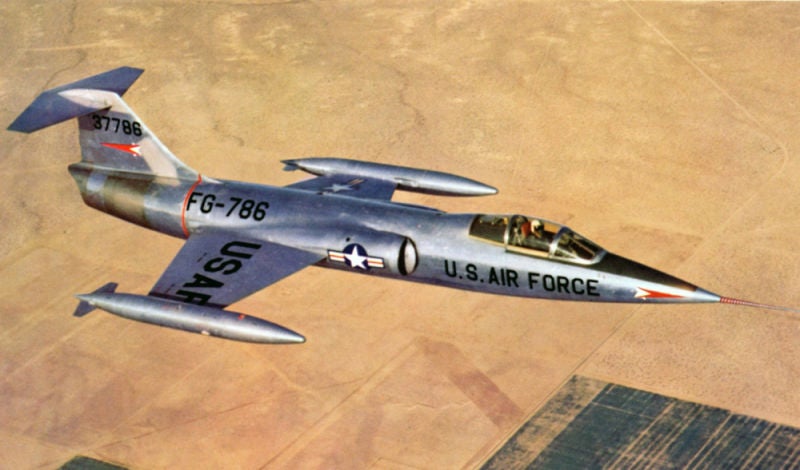
March 4, 1954 – The first flight of the Lockheed F-104 Starfighter. Most of the earliest jet fighters were built with the prevailing technology of WWII, and that meant straight wings. But when troves of data on the benefits of swept wings were captured from the Germans near the end of the war, the swept wing became a standard design element of jet fighters going forward. Delta wings, another design element pioneered by the Germans, were also adopted. But if anybody was going to buck that trend, it was Lockheed’s !!!error: Indecipherable SUB-paragraph formatting!!! , perhaps America’s greatest aircraft engineer and one who became famous for doing things his way.
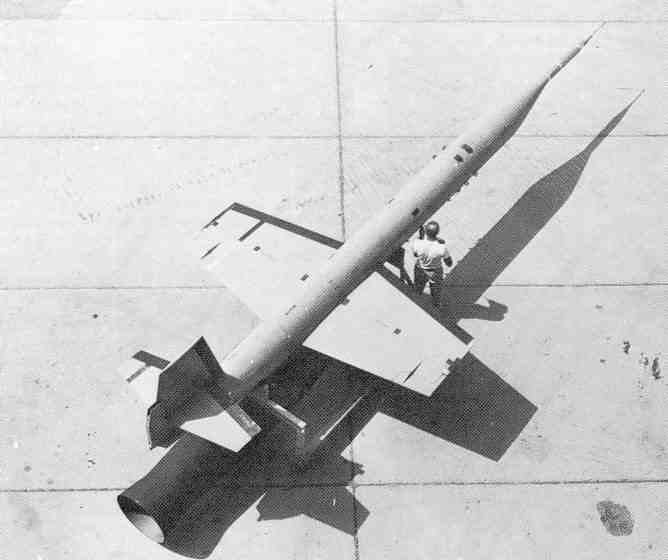
The Lockheed X-7 missile, with its trapezoidal wings
During the Korean War, American pilots came face to face with smaller, more nimble Russian fighters like the !!!error: Indecipherable SUB-paragraph formatting!!! . While the Americans ultimately prevailed, due in large part to better training and more experienced pilots, it was a much closer fight in the early part of the war. In 1951, Johnson traveled to Korea interview US pilots and asked them directly what they wanted to see in a new fighter. Most said they wanted something smaller, faster, and more maneuverable. So Johnson, never one to do things in half measures, envisioned a very small fighter wrapped tightly around a single powerful engine that could race at Mach 2 in level flight. For the all important wings, Johnson eschewed the traditional swept or delta wings in favor of minimal, trapezoidal wings that bore a striking resemblance to the wings of the experimental !!!error: Indecipherable SUB-paragraph formatting!!! missile under development at the time. Johnson also gave the wings a slight anhedral, or downward angle, to help counteract potentially deadly !!!error: Indecipherable SUB-paragraph formatting!!! , and high-pressure air was blown over the flaps on landing to help decrease landing speeds. Where the wings of contemporary aircraft were used to house fuel or landing gear, the wings of the Starfighter were razor thin, so thin in fact that the leading edges were covered with a felt cap to protect the ground crews who serviced the fighter. Not all of Johnson’s ideas were winners. Early Starfighters were given a downward-firing ejection seat over concerns that pilots would not clear the T-tail, though this questionable arrangement was changed to a standard upward firing ejection seat in subsequent models.
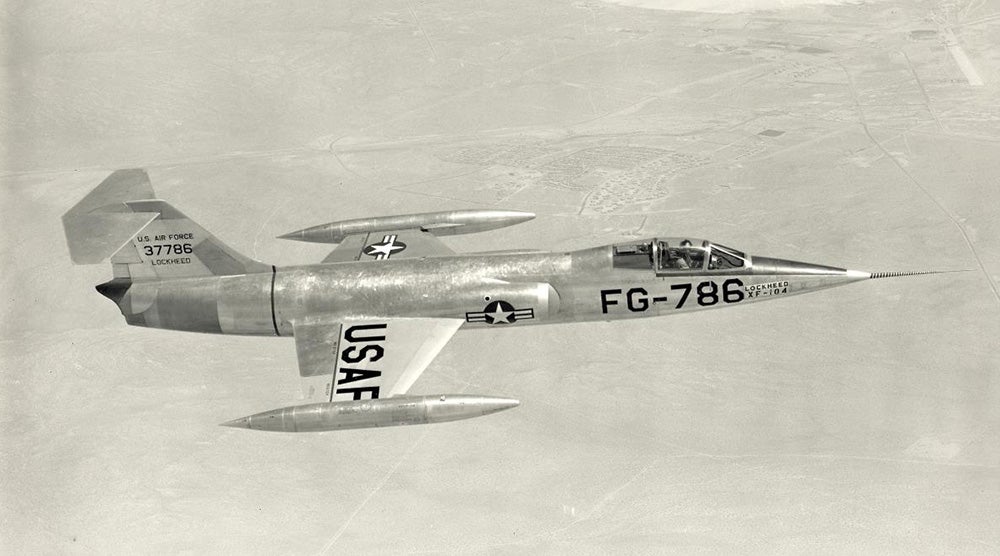
Prototype XF-104
The Starfighter moved from contract to first flight in less than one year, but development of the new fighter proved difficult, and it was four years before the first Starfighters entered service with the USAF. Then, just three months later, all F-104s were grounded because of engine problems and a series of accidents. The F-104A also suffered from a lack of all-weather capability and short range, and after only one year of frontline Air Force service, the A model was passed to units of the Air National Guard or repurposed as the unmanned QF-104 target drone. Lockheed responded to these shortcomings with the F-104C, which added an improved fire control radar and capacity for more ordnance, and the Air Force sent the Starfighter to Vietnam. Though it served two tours, F-104 pilots claimed no enemy kills while losing 14 of their own aircraft in the process. By this time, the Air Force had lost interest in the Starfighter, and that could have been the end of the road for Johnson’s innovative little fighter.
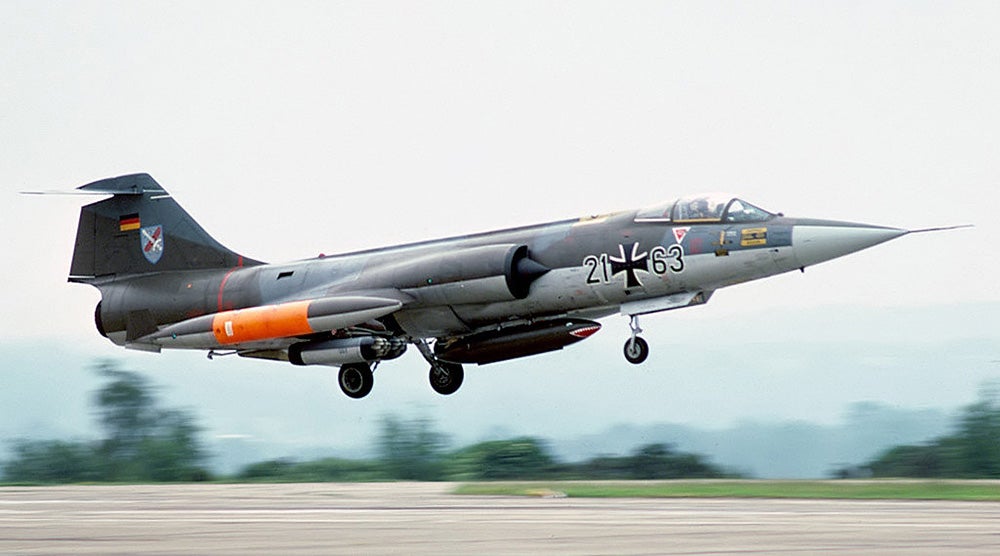
Lockheed (Messerschmitt) F-104G Starfighter
The Starfighter won a reprieve from the scrap pile in 1959 when a group of European countries, led by Germany, decided to procure the F-104 as a multi-mission attack fighter to replace older jet aircraft in service. The selection was controversial, though, and accusations that Lockheed bribed the European officials to accept the Starfighter dogged the decision. The F-104G (G for Germany) was built under license by Canadair and by a consortium of European companies including
!!!error: Indecipherable SUB-paragraph formatting!!!
/
!!!error: Indecipherable SUB-paragraph formatting!!!
, Dornier,
!!!error: Indecipherable SUB-paragraph formatting!!!
,
!!!error: Indecipherable SUB-paragraph formatting!!!
, and
!!!error: Indecipherable SUB-paragraph formatting!!!
. Dubbed the Super Starfighter, it had a strengthened fuselage and wing, increased fuel capacity, enlarged fin and redesigned flaps for combat maneuvering. And, unlike the original F-104 which sacrificed a fire control radar to save space and weight, the F-104G was fitted with a radar as well as an inertial navigation system, the first on any production fighter. Despite these improvements the F-104G service with Germany was not without problems, particularly with wing strength and pilot workload, and it was not popular. Nevertheless, the F-104G made up the bulk of all Starfighters produced, with 1,122 out of a total of 2,578 built by the European consortium. Though the US Air Force was done with the Starfighter by 1969, it would serve in Europe for another 10 years, with the final aircraft, the Aeritalia F-104S, serving until 2004.
!!! UNKNOWN CONTENT TYPE !!!
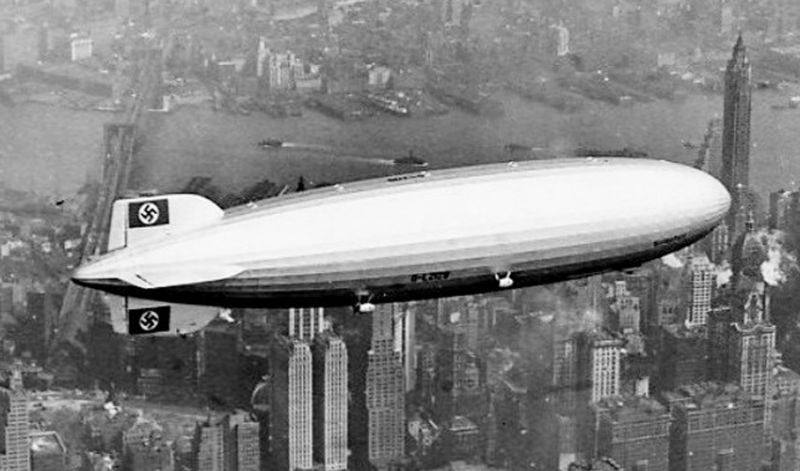
March 4, 1936 – The first flight of the Hindenburg (LZ 129). Though the airplane gets much of the glory for helping mankind slip the surly bonds of earth, it was a balloon that first took men into the air on November 21, 1783, when the !!!error: Indecipherable SUB-paragraph formatting!!! flew their hot air balloon over France. Less than two months later, !!!error: Indecipherable SUB-paragraph formatting!!! and the !!!error: Indecipherable SUB-paragraph formatting!!! , again in France, flew the world’s first hydrogen balloon, not only ascending to a then unheard of altitude of 3,000 meters, but also carrying aloft instruments to measure temperature and barometric pressure. By 1785, a hydrogen balloon made the first flight across the English Channel and, in 1852, the first powered and steerable dirigible took to the skies in France. This semi-rigid airship paved the way for huge airships with metal frames housing bags of hydrogen or helium, culminating with the Hindenburg , the largest aircraft ever built.
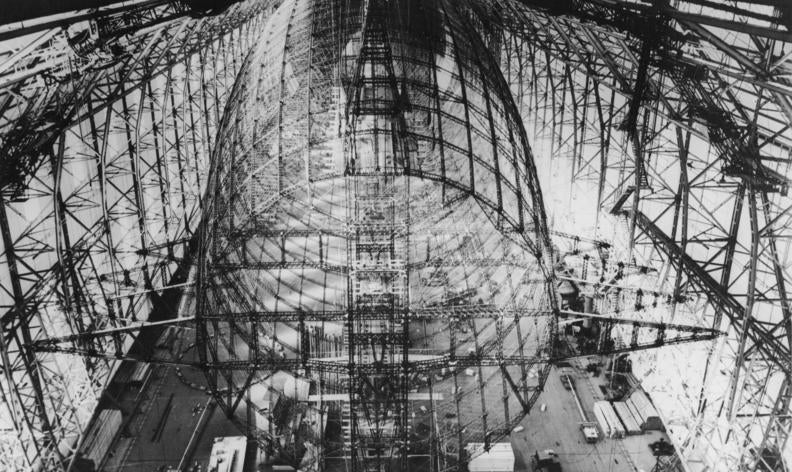 !!!CAPTION ERROR: MAY BE MULTI-LINE OR CONTAIN LINK!!!
!!!CAPTION ERROR: MAY BE MULTI-LINE OR CONTAIN LINK!!!
The first Zeppelin, a rigid airship named after its creator, German !!!error: Indecipherable SUB-paragraph formatting!!! , entered commercial service in 1910. Eventually, Zeppelins became the world’s first airliners, and transatlantic flights became commonplace. The Hindenburg , German dirigible LZ-129 ( Luftschiff Zeppelin #129, registration D-LZ129) was the lead ship of the Hindenburg class. Designed and built by the !!!error: Indecipherable SUB-paragraph formatting!!! ( Luftschiffbau Zeppelin GmbH ) and named after the late !!!error: Indecipherable SUB-paragraph formatting!!! , the President of Germany from 1925-1934, Hindenburg was constructed of a !!!error: Indecipherable SUB-paragraph formatting!!! framework with with 16 cotton gas bags attached. The outer skin was made of cotton and !!!error: Indecipherable SUB-paragraph formatting!!! with a reflective coating to protect the gas bags from ultraviolet and infrared radiation. With enormous swastikas painted in the tail fins, Hindenburg was as much an object of Nazi propaganda as it was a transatlantic passenger vessel.
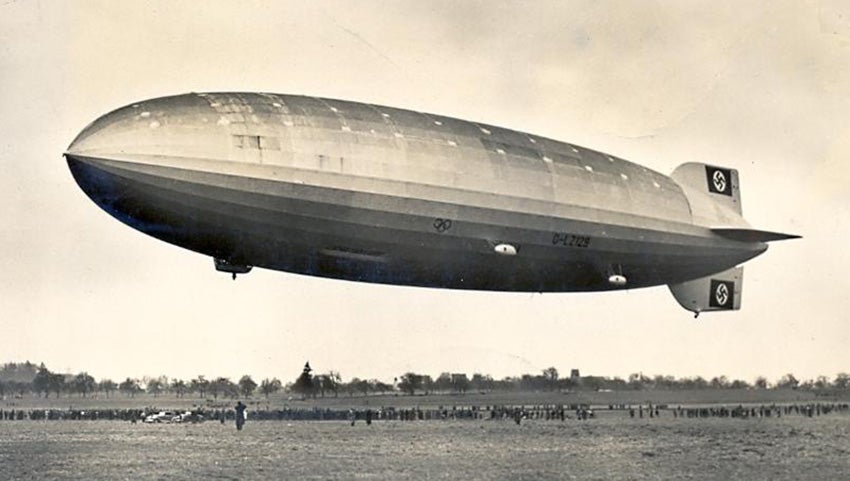 !!!CAPTION ERROR: MAY BE MULTI-LINE OR CONTAIN LINK!!!
!!!CAPTION ERROR: MAY BE MULTI-LINE OR CONTAIN LINK!!!
Hindenburg was originally built to be filled with helium, but helium was rare and came at an exorbitant cost. The only source was the United States, where helium was a byproduct of natural gas mining. Construction of the Hindenburg went ahead regardless, and when the US refused to lift its export ban on helium, Hindenburg’s designers made the fateful decision to switch to highly flammable hydrogen instead, even though the dangers of hydrogen were well known. Hindenburg’s first commercial flight took place on March 31, 1935, with the first of 17 transatlantic flights culminating in Lakehurst, New Jersey on May 6, 1936. Two months later, Hindenburg made a record double crossing of the Atlantic in just under six days. But despite its unparalleled speed and size, Hindenburg would become most famous not for setting records, but for the devastating crash that marked its final flight.
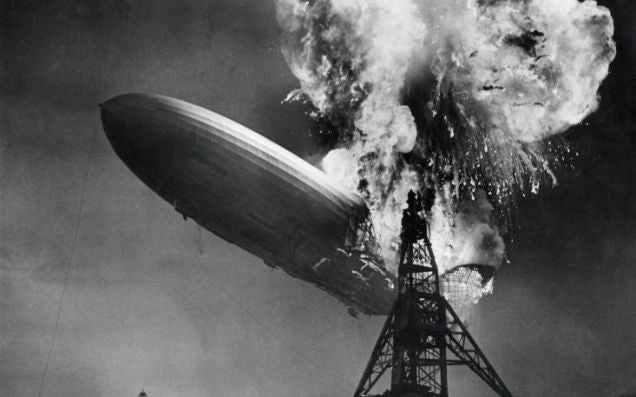 !!!CAPTION ERROR: MAY BE MULTI-LINE OR CONTAIN LINK!!!
!!!CAPTION ERROR: MAY BE MULTI-LINE OR CONTAIN LINK!!!
Hindenburg
left Frankfurt on May 6, 1937 on a transatlantic crossing to Lakehurst. It’s arrival was initially delayed by a line of thunderstorms, but
Hindenburg
was finally cleared to land at about 7:00 pm. Twenty-one minutes later, shortly after dropping mooring lines to the ground crew,
Hindenburg
suddenly erupted into flames and crashed. In less than thirty seconds, the massive Zeppelin was reduced to a smoldering wreck of twisted, charred metal. Thirteen of the 36 passengers died, along with 22 members of the crew of 61 along with 1 man on the ground. The cause of the crash remains a topic of much conjecture even to this day, and no exact cause has ever been determined. Some suspect sabotage, others suggest atmospheric conditions related to the thunderstorms in the area. One of the more plausible theories is that hydrogen gas leaking from one of the cells was ignited by static electricity. After the crash, the duralumin hulk was returned to Germany and recycled for use in the construction of Luftwaffe aircraft.
!!!error: Indecipherable SUB-paragraph formatting!!!
(LZ 130)
,
Hindenburg’s
sister ship and the last great Zeppelin built by Germany, was scrapped in 1940 before its completion, and its duralumin frame was also melted down for the construction of warplanes.
!!! UNKNOWN CONTENT TYPE !!!
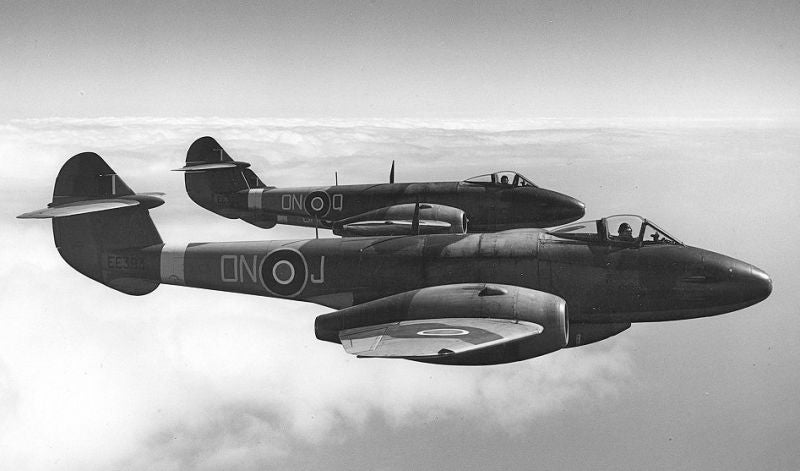
March 5, 1943 – The first flight of the Gloster Meteor. When the Wright Flyer took to the skies of Kitty Hawk, North Carolina in 1903, it was powered by a homebuilt 4-cylinder engine that generated 12 horsepower and turned a wooden propeller. Over the ensuing years, engines became more powerful, !!!error: Indecipherable SUB-paragraph formatting!!! and radial engines were introduced, and the piston-powered propeller plane reached its zenith by the late stages of WWII. But the years before the war also witnessed the development of an entirely new powerplant, one that would take the airplane from the Wright Brother’s six miles per hour to beyond the speed of sound. The story of the Gloster Meteor is one that is inextricably linked to the story of the jet engine.
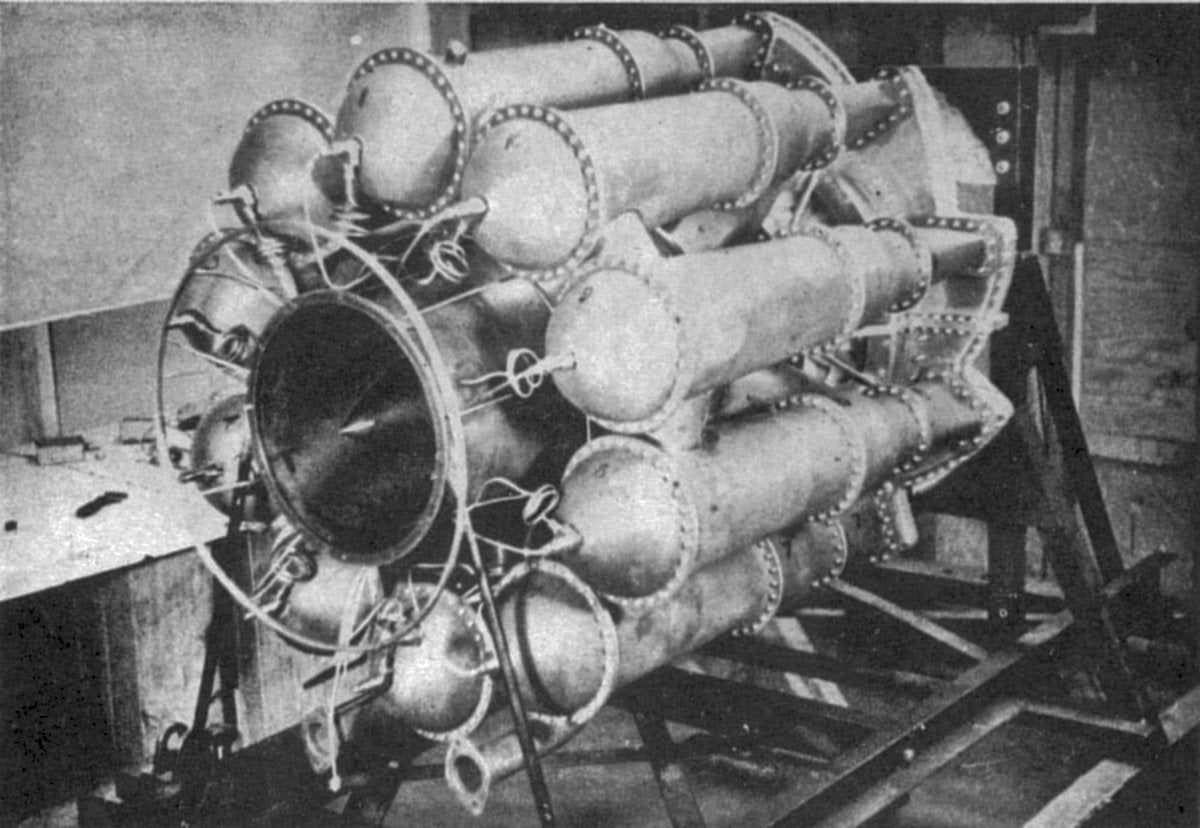
Frank Whittle’s W2 turbojet engine
Since the first operational jets arrived late in WWII, the development of the turbojet engine is often associated with that conflict. However, its origins can be traced back to well before the war began. The Germans fielded the first operational jet fighter with the !!!error: Indecipherable SUB-paragraph formatting!!! , but work on a jet engine in England had begun by the late 1920s. Royal Air Force engineer !!!error: Indecipherable SUB-paragraph formatting!!! had been working on the principle of a !!!error: Indecipherable SUB-paragraph formatting!!! , where a piston engine is used to drive a compressor. Whittle’s breakthrough came when he thought of replacing the piston engine of the motorjet with a turbine, and he patented his first design in 1930. By 1936, he had formed his own company, !!!error: Indecipherable SUB-paragraph formatting!!! , to continue work on his concepts. Though he found it difficult to find financial backers for his project, and hard to find anybody to build a plane to put the new engine in, Whittle eventually visited the !!!error: Indecipherable SUB-paragraph formatting!!! in 1939. There he met Gloster’s chief engineer, !!!error: Indecipherable SUB-paragraph formatting!!! , who took an interest in Whittle’s new engine and began work on an aircraft design in which to implement the turbojet. The first proof of concept aircraft was the !!!error: Indecipherable SUB-paragraph formatting!!! , a single-engine aircraft that took its maiden flight on May 15, 1941.
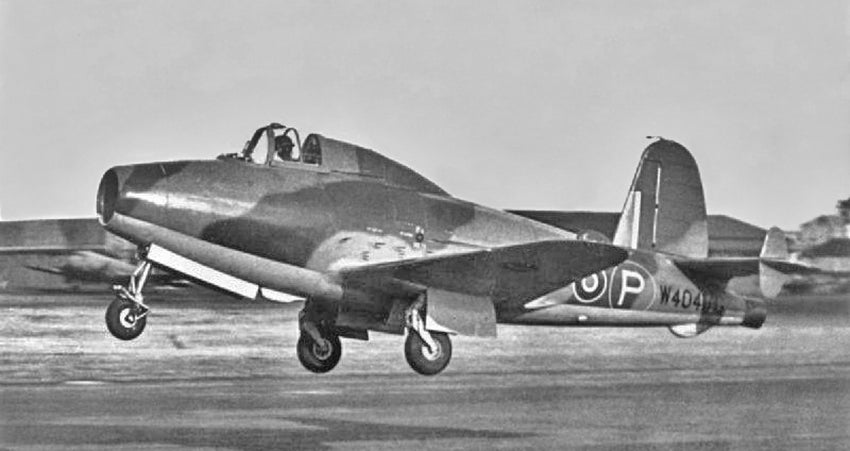
Gloster E.28/39, the aircraft that proved that Frank Whittle’s turbojet engine would work
With proof that the turbojet worked, Gloster moved ahead with work on a production fighter, but decided to use two engines to make up for the lack of power in the early turbojet. By 1940, Carter had the first proposal for the twin-engine Meteor fighter, and within six months Gloster received an order for eight prototypes under Specification F9/40, which was written to match the fighter already in development. The Meteor was built in a modular fashion from five main sections: nose, forward fuselage, central section, rear fuselage, and tail sections. Various companies were contracted to build the modules, and this allowed production to be dispersed. It also facilitated disassembly and transport of the Meteor.
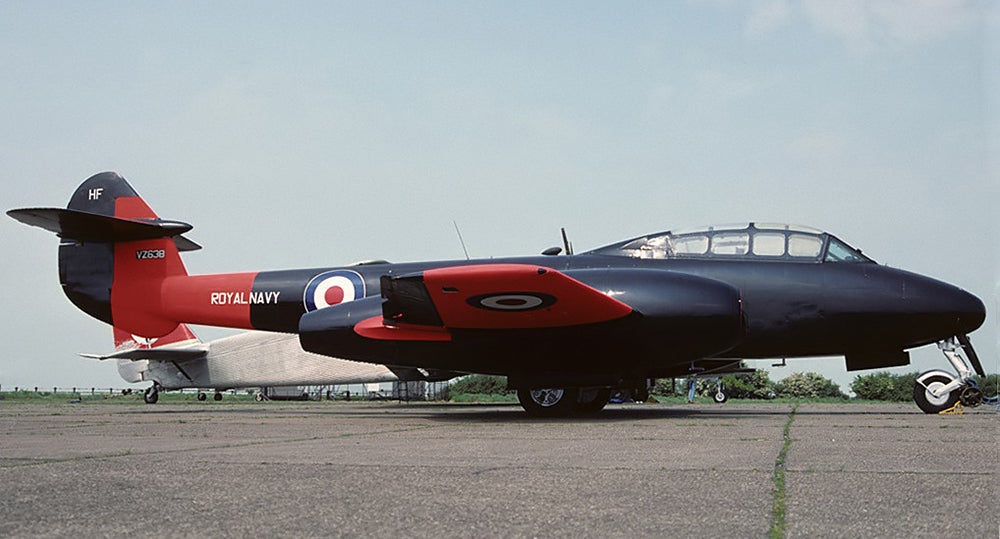
Two-seat Gloster Meteor T7
The Meteor was introduced on July 27 1944, with the first aircraft delivered to No. 616 Squadron of the RAF. With a top speed of 600 mph, 100 mph faster than the !!!error: Indecipherable SUB-paragraph formatting!!! , the Meteor was first flown against the German !!!error: Indecipherable SUB-paragraph formatting!!! that were terrorizing England. On August 4, 1944, Meteor pilots claimed their first kills when they shot down two V-1s, and they eventually claimed 14 “buzz bombs” by the end of the war. From their introduction, Meteors were forbidden from flying over German-held territory for fear that one of the fighters would fall into enemy hands. But when the V-1 threat subsided, Meteors finally were finally sent to Europe in January of 1945, but the clash between the Meteor and the !!!error: Indecipherable SUB-paragraph formatting!!! , Germany’s first operational jet fighter, never occurred.
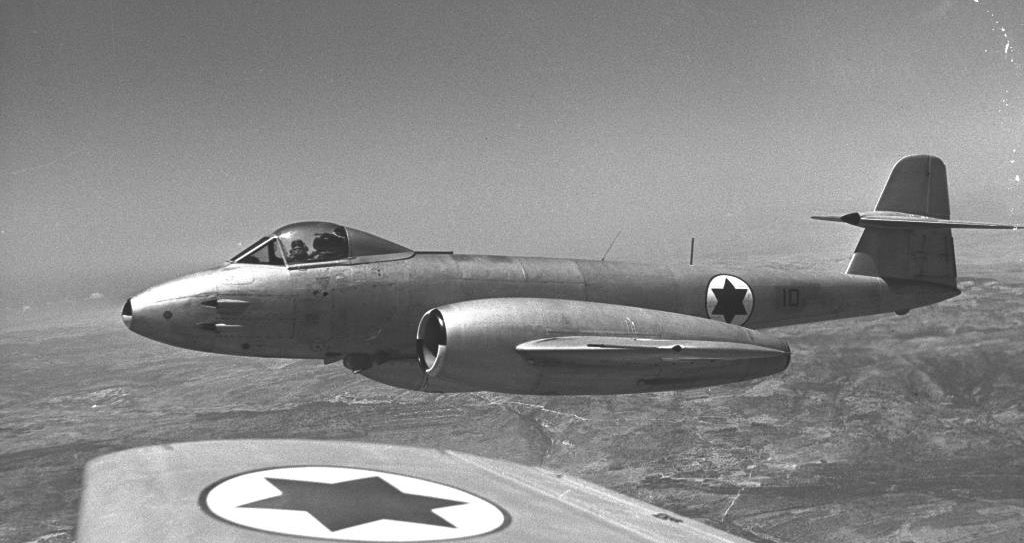
Gloster Meteor F.8 of the Israeli Air Force in 1954
Production and development of the Meteor continued after the war, with improvements made in the design, fuel capacity, radar and weapons systems, as well as the development of a two-seat trainer version. F8 Meteors flying with the Royal Australian Air Force saw significant action during the Korean War. Nearly 4,000 Meteors were built by the time production ended in 1955, and they were widely exported. British Meteors ended their days with the RAF as target tugs, flying into the 1980s. Despite their retirement, Meteors are still providing useful service today. The !!!error: Indecipherable SUB-paragraph formatting!!! , pioneers in ejection seat technology, !!!error: Indecipherable SUB-paragraph formatting!!! a pair of Meteors to perform flight tests of the latest ejection seats.
!!! UNKNOWN CONTENT TYPE !!!
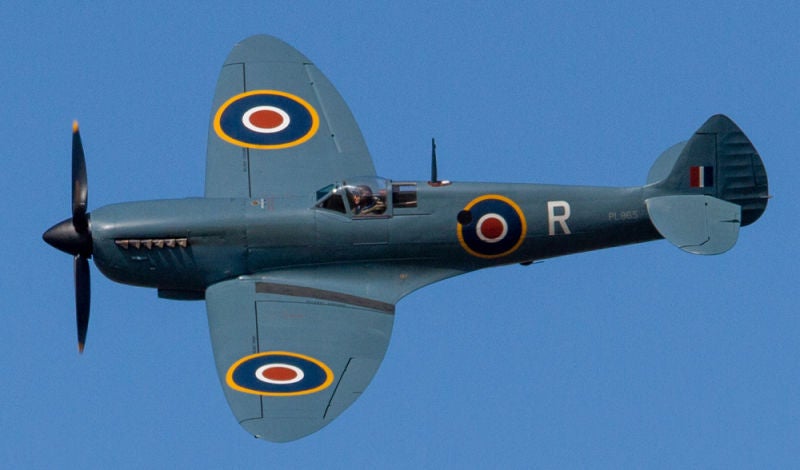
March 5, 1936 – The first flight of the Supermarine Spitfire. The period between World War I and World War II is known as the !!!error: Indecipherable SUB-paragraph formatting!!! , a period marked by rapid advances in aircraft design and construction. Aviation moved from the purview of the military to civilian pilots, air races became a world phenomenon, and prestigious trophies and prize purses were the driving force behind significant advances in speed and aerodynamic design. !!!error: Indecipherable SUB-paragraph formatting!!! had made a name for itself building racing seaplanes, and had won the !!!error: Indecipherable SUB-paragraph formatting!!! three times between 1927-1931 so, with the prospect of war looming in Europe by the mid-1930s, the Royal Air Force turned to the company to develop a new fighter that could intercept and defeat faster, more advanced German aircraft.
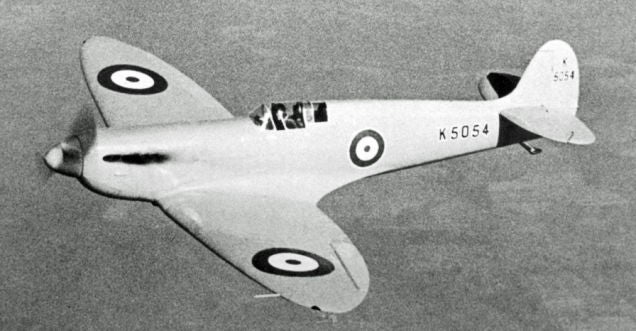
Spitfire prototype
Drawing on experience from their racing days, Supekrmarine first developed the !!!error: Indecipherable SUB-paragraph formatting!!! , a monoplane with fixed landing gear and an open cockpit. But problems with the !!!error: Indecipherable SUB-paragraph formatting!!! engine, coupled with poor performance, caused Supermarine to abandon the Type 224 for a more modern design. What followed was the Type 300, which underwent significant subsequent development to include an enclosed cockpit, retractable landing gear, smaller wings, and an oxygen supply for the pilot. Supermarine designer !!!error: Indecipherable SUB-paragraph formatting!!! also gave the Spitfire one of its most recognizable features: its graceful elliptical wing, with an exceptionally thin cross section that helped increase the Spitfire’s top speed. But most importantly, they settled on the Rolls-Royce PV-12 engine, the precursor to the mighty !!!error: Indecipherable SUB-paragraph formatting!!! . The Spitfire was an immediate winner. Upon landing after the first flight of the prototype, Vickers chief test pilot !!!error: Indecipherable SUB-paragraph formatting!!! reportedly said, “Don’t touch anything.”
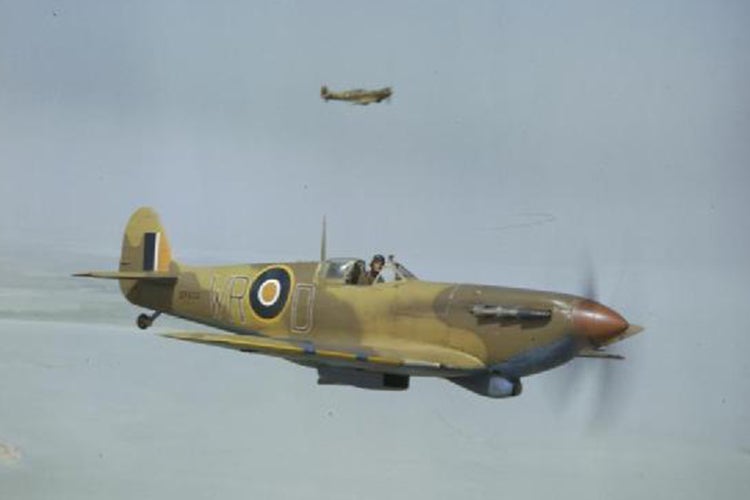
Spitfire Mk V over Tunisia in 1943
Though the Spitfire was well-received, its Merlin engine was not without its teething problems. Unlike the fuel injected engines in use by the Luftwaffe, the Merlin had a carburetor. This made the Spitfire susceptible to flooding in a nose-over dive or inverted flight. At first, pilots learned to combat this problem by first half-rolling the aircraft before a dive. But until a permanent solution could be found with the addition of a pressurized carburetor, it was !!!error: Indecipherable SUB-paragraph formatting!!! who saved the day. Shilling devised a restrictor, nicknamed !!!error: Indecipherable SUB-paragraph formatting!!! , that restricted the flow of fuel to no more than the engine could use at full power. While only a stopgap measure, the restrictor kept the Spitfire flying until the new carburetors could be developed. In the final round of Spitfire production, the Merlin gave way to the !!!error: Indecipherable SUB-paragraph formatting!!! which employed a pressure-injection carburetor and boasted 2,340 hp and a top speed of nearly 500 mph.
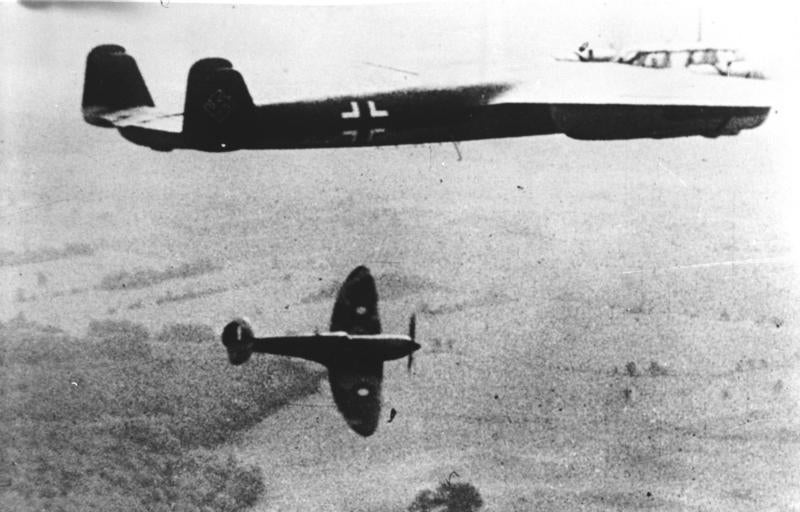
A Spitfire harries a Dornier Do 17 over England during the Battle of Britain
During the !!!error: Indecipherable SUB-paragraph formatting!!! , the Spitfire, along with the !!!error: Indecipherable SUB-paragraph formatting!!! , faced the onslaught of the Luftwaffe. Though the less glamorous Hurricane fought in greater numbers, the Spitfire became the better known fighter of the battle, as dashing RAF fighter pilots in the “Spits” dueled with German fighters high in the sky while the “Hurrys,” which were no match for the !!!error: Indecipherable SUB-paragraph formatting!!! , slugged it out with the bombers at lower altitudes. Head to head with the Me 109, the Spitfire pilot appreciated the firepower provided by its eight Browning .303 machine guns. While not as powerful as the canon used by the Germans, Spitfire pilots could concentrate more firepower on the enemy.
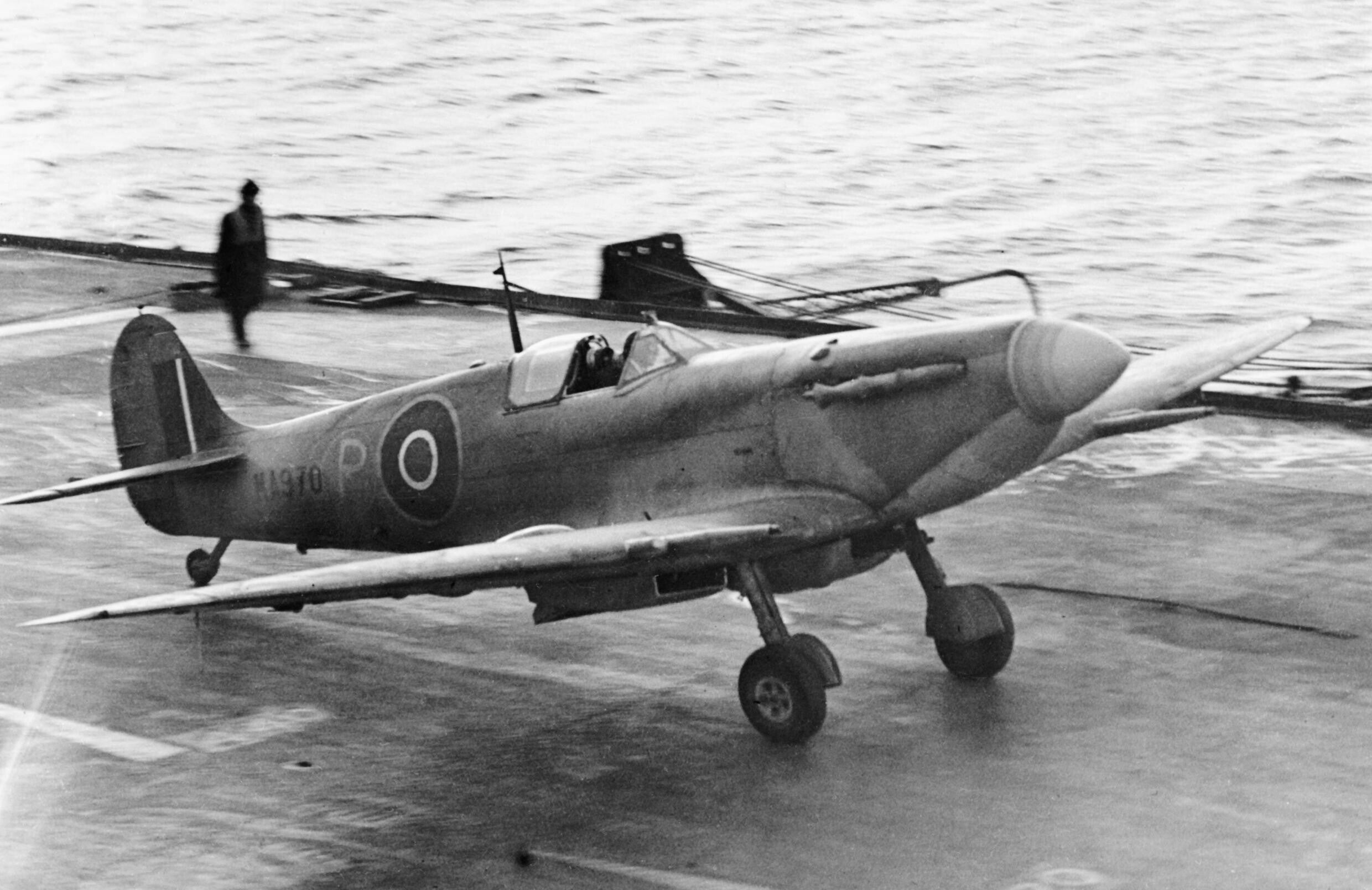
Supermarine Seafire landing aboard HMS Illustrious in 1943
The Spitfire was continuously improved and produced throughout the war. Supermarine developed numerous variants, including a carrier-based version which was nicknamed the !!!error: Indecipherable SUB-paragraph formatting!!! , and export Spitfires were flown by 35 countries around the world. The mission of the Spitfire didn’t end with !!!error: Indecipherable SUB-paragraph formatting!!! . They continued patrolling German skies after the war, Spitfire pilots flew over 1,800 sorties during the !!!error: Indecipherable SUB-paragraph formatting!!! , and the final operational sortie flown by the Spitfire took place on April 1, 1954. In all, more than 20,000 Spits were produced from 1938-1948, making it the third-highest produced warplane behind the !!!error: Indecipherable SUB-paragraph formatting!!! (36,183) and the Bf 109 (34,852).
!!! UNKNOWN CONTENT TYPE !!!
Short Takeoff
!!! UNKNOWN CONTENT TYPE !!!
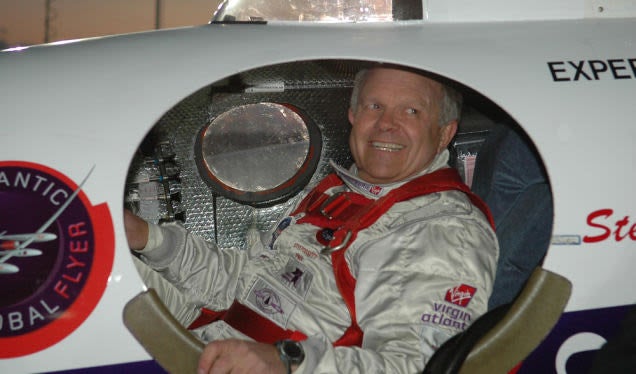
March 3, 2005 – Steve Fossett completes the first nonstop solo circumnavigation of the Earth. Millionaire adventurer !!!error: Indecipherable SUB-paragraph formatting!!! took off from Salina, Kansas on February 28, 2005 in the !!!error: Indecipherable SUB-paragraph formatting!!! , an aircraft designed by !!!error: Indecipherable SUB-paragraph formatting!!! and built by Rutan’s company !!!error: Indecipherable SUB-paragraph formatting!!! with an airframe made of carbon fiber reinforced plastic and powered by a single !!!error: Indecipherable SUB-paragraph formatting!!! turbofan engine. Fossett flew eastward from Kansas and, at an average speed of 342.2 mph, he returned to Kansas slightly more than 67 hours and 22,936 later to claim the absolute record for “speed around the world, nonstop and non-refueled.” The following year, Fossett piloted the GlobalFlyer 25,766 miles nonstop to set the world’s record for the greatest unrefueled distance ever traveled in an aircraft.
!!! UNKNOWN CONTENT TYPE !!!
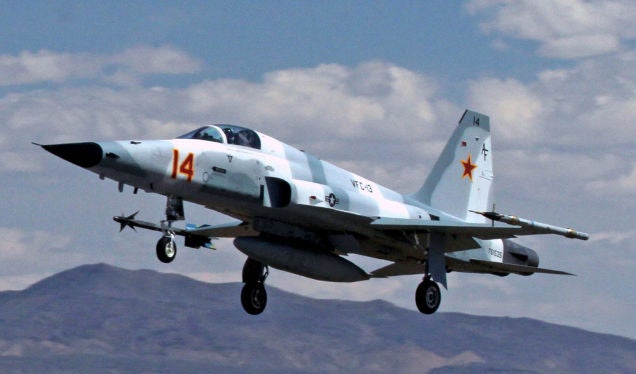
March 3, 1969 – The US Navy establishes the Fighter Weapons School at NAS Miramar, popularly known as Topgun or TOPGUN.
In 1968, the US Navy published the
!!!error: Indecipherable SUB-paragraph formatting!!!
, a review of Navy air-to-air missile system capabilities from 1965-1968, a period when US pilots suffered high losses during the
!!!error: Indecipherable SUB-paragraph formatting!!!
campaign. Rather than place the blame for American aircraft losses entirely on early air-to-air missiles or missile systems, the Ault report recommended that an Advanced Fighter Weapons School be created to re-educate pilots in air combat maneuvering (ACM, or dogfighting), skills that had languished after the US started to rely solely on guided missiles. Select Naval Aviators and flight officers are sent to train at Topgun, then return to their operational units to share what they learned. In 1996, Topgun was merged into the
!!!error: Indecipherable SUB-paragraph formatting!!!
at NAS Fallon in Nevada.
!!! UNKNOWN CONTENT TYPE !!!
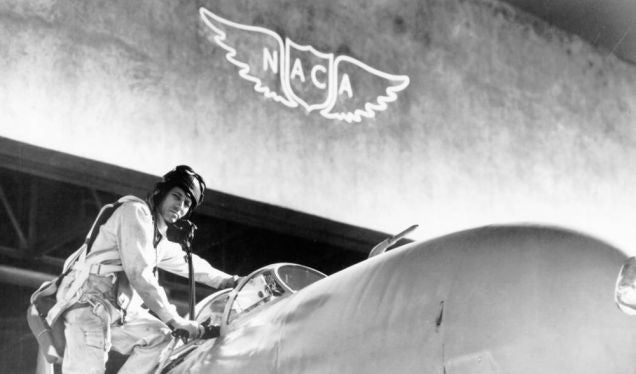
March 3, 1915 – The National Advisory Committee for Aeronautics is founded, a US government agency created to promote the technological development of aviation in the United States. NACA was at the forefront of some of the most important advances in aircraft design, such as the !!!error: Indecipherable SUB-paragraph formatting!!! , which improved aerodynamics of radial engines and increased fuel efficiency, the !!!error: Indecipherable SUB-paragraph formatting!!! , which was an aerodynamic air intake used on jet aircraft, and the !!!error: Indecipherable SUB-paragraph formatting!!! which maximized air pressure both above and below the wing. NACA took the lead in the development of advanced jet aircraft in the period immediately following WWII, and was responsible for many of the significant advances made in speed and altitude. With the beginning of the American space program, NACA was dissolved and its assets were transferred to the fledgling !!!error: Indecipherable SUB-paragraph formatting!!! (NASA) in 1958.
!!! UNKNOWN CONTENT TYPE !!!
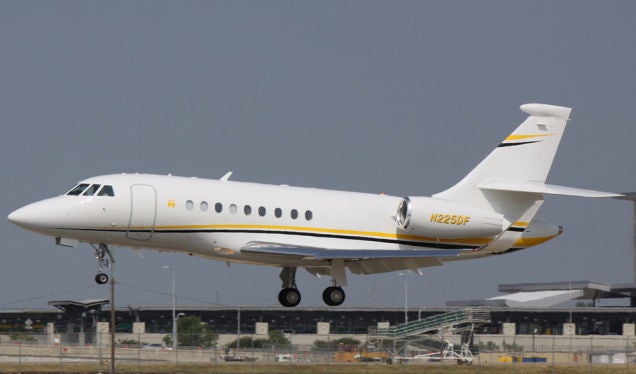
March 4, 1993 – The first flight of the Dassault Falcon 2000,
a business jet made by the French company
!!!error: Indecipherable SUB-paragraph formatting!!!
and a smaller development of the
!!!error: Indecipherable SUB-paragraph formatting!!!
. Where the 900 is a trijet, the 2000 has only two engines, yet it is still capable of intercontinental range. Continued development of the 2000 has brought increased fuel efficiency, extended range, and short runway capability. Dassault has also proposed a maritime reconnaissance version and, in addition to its civilian operators, the 2000 is currently flown by the militaries of France, Bulgaria, Slovenia and the Republic of Korea. Powered by two
!!!error: Indecipherable SUB-paragraph formatting!!!
turbofans, the 2000 is capable of speeds of Mach 0.85 with a range of up to 6,000 nautical miles.
!!! UNKNOWN CONTENT TYPE !!!
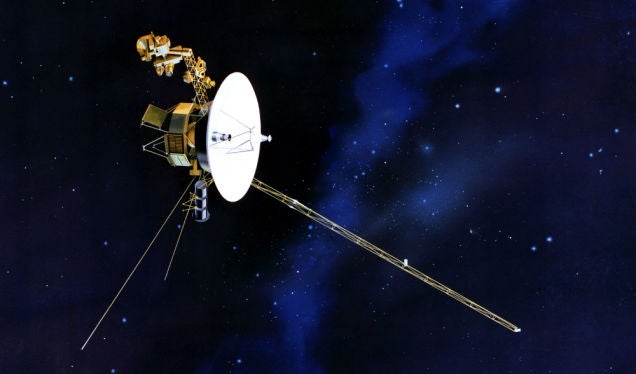
March 5, 1979 – Voyager 1 makes its closest approach to Jupiter. !!!error: Indecipherable SUB-paragraph formatting!!! was sent to space on September 5, 1977 on a mission to study the outer solar system. Launched 16 days after !!!error: Indecipherable SUB-paragraph formatting!!! , Voyager 1 has operated for more than 38 years and continues to return data to Earth. After close flybys of Jupiter, Saturn and Saturn’s moon Titan, Voyager 1 continued to the boundaries of the outer !!!error: Indecipherable SUB-paragraph formatting!!! and, on August 25, 2012, it became the first spacecraft to enter interstellar space. Voyager will continue functioning until its batteries run out in 2025.
!!! UNKNOWN CONTENT TYPE !!!
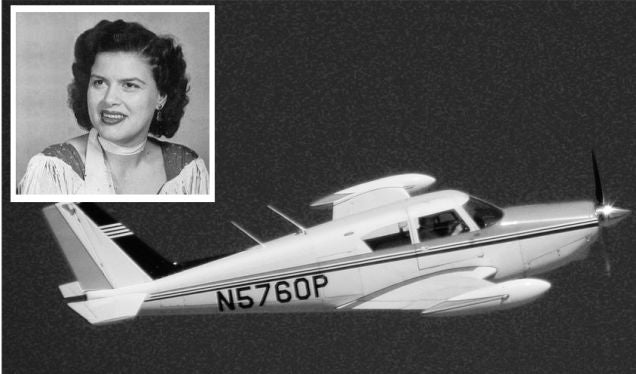
March 5, 1963 – A plane crash claims the life of country music singer Patsy Cline. Following a benefit concert in Kansas City, Kansas, Cline was unable to leave following the show because the local airport was fogged in. She passed on an offer of a car ride to Nashville, opting instead to fly out the next day. On the day of the crash, she boarded a !!!error: Indecipherable SUB-paragraph formatting!!! (N-7000P) for the flight to Nashville. After a stop for fuel in Dyersburg, Tennessee, the pilot chose to continue despite worsening weather, even though he was not qualified for instrument flying ( !!!error: Indecipherable SUB-paragraph formatting!!! ). Cline’s plane crashed 90 miles from Nashville, and the NTSB report cited the cause as the pilot’s loss of control in adverse conditions. Along with Cline, musicians !!!error: Indecipherable SUB-paragraph formatting!!! , !!!error: Indecipherable SUB-paragraph formatting!!! , and pilot Randy Hughes were killed. (Cline photo by Four Star Records via !!!error: Indecipherable SUB-paragraph formatting!!! ; Piper PA-24 photo (not accident aircraft) by Alan Radecki via !!!error: Indecipherable SUB-paragraph formatting!!! )
!!! UNKNOWN CONTENT TYPE !!!
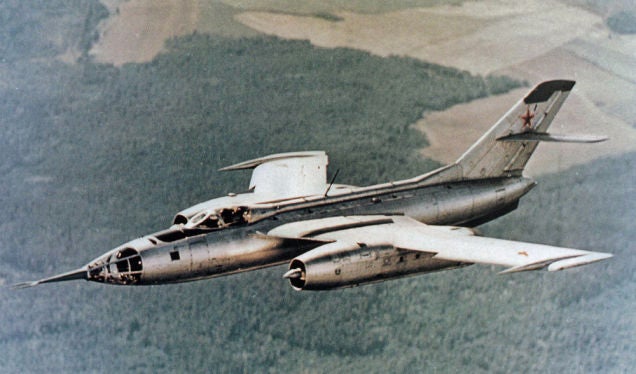
March 5, 1958 – The first flight of the Yakovlev Yak-28, a Cold War era tactical bomber produced by the Soviet Union. The Yak-28 was powered by two !!!error: Indecipherable SUB-paragraph formatting!!! afterburning turbojets mounted in pods beneath 45-degree swept wings. Though designed as a tactical bomber, the Yak-28 was also used for reconnaissance, electronic warfare, as an interceptor, and as a trainer, and its !!!error: Indecipherable SUB-paragraph formatting!!! —Brewer (jet bomber), Fireball (jet fighter), and Maestro (miscellaneous)—reflected the mission of the particular variant. It had a top speed of 735 mph and was armed with one or two 30mm cannons and up to 4,410 pounds of bombs and missiles. The Yak-28 was introduced in 1960 and served the Soviet Union, Russia, Turkmenistan and Ukraine. Nearly 1,800 were produced.
!!! UNKNOWN CONTENT TYPE !!!
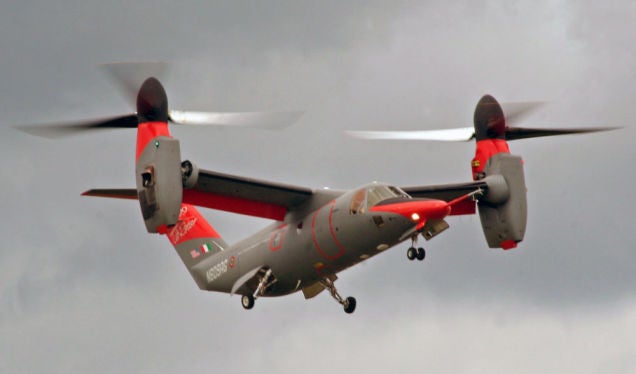
March 6, 2003 – The first flight of the AgustaWestland AW609, a twin-engine !!!error: Indecipherable SUB-paragraph formatting!!! !!!error: Indecipherable SUB-paragraph formatting!!! aircraft being developed for the civilian market. Similar to the !!!error: Indecipherable SUB-paragraph formatting!!! , the AW609 is capable of vertical takeoff and landing, with transition to forward flight provided by turboprop engines mounted in swiveling nacelles on the end of the wings. !!!error: Indecipherable SUB-paragraph formatting!!! plans to market the AW609 to VIP customers and the offshore oil and gas industry. Development was slowed after the crash of the second prototype in October 2015 which killed two test pilots. For still unknown reasons, the aircraft broke up in midair during high speed testing. The AW609 is still awaiting certification, and AgustaWestland is considering a site in the US for production. (Photo by pjs2005 via !!!error: Indecipherable SUB-paragraph formatting!!! )
!!! UNKNOWN CONTENT TYPE !!!
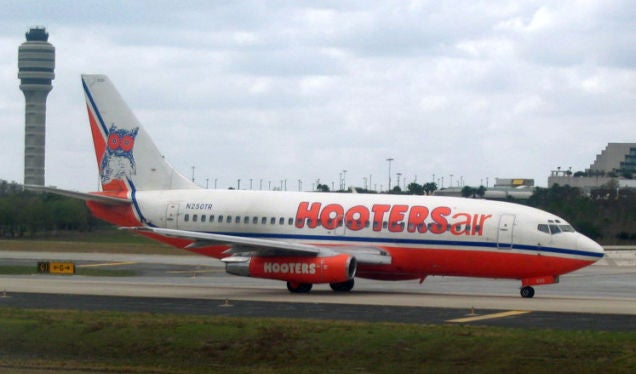
March 6, 2003 – The launch of Hooters Air. Hooters Air was founded by Robert Brooks, the owner of Hooters of America, a restaurant perhaps best known for the revealing attire worn by its waitresses. Brooks acquired !!!error: Indecipherable SUB-paragraph formatting!!! in 2002, and rebranded the jets in Hooters Air livery. The airline focused on the golfing set, hoping to drum up business with passengers, particularly men, who wanted to take flyaway golf trips. Each flight was staffed by two Hooters waitresses in the regular Hooters attire in addition to a standard complement of flight attendants who wore traditional uniforms. Faced with increased fuel costs following Hurricanes Rita and Katrina, Hooters Air ceased operations on April 17, 2006 after an estimated cost of $40 million spent on the venture.
!!! UNKNOWN CONTENT TYPE !!!

March 6, 1927 – The birth of US astronaut Gordon Cooper. Born in Shawnee, Oklahoma, Leroy Gordon “Gordo” Cooper was an engineer, test pilot, US Air Force pilot, and one of the !!!error: Indecipherable SUB-paragraph formatting!!! , the original seven astronauts who took part in !!!error: Indecipherable SUB-paragraph formatting!!! , NASA’s first manned space program and precursor to the !!!error: Indecipherable SUB-paragraph formatting!!! and !!!error: Indecipherable SUB-paragraph formatting!!! programs. On the final Mercury mission in 1963, Cooper piloted his Faith 7 capsule on the longest flight of the Mercury program, and was the first American to sleep in space. He was also the last American astronaut launched into space on a solo orbital mission. Cooper flew as Command Pilot of !!!error: Indecipherable SUB-paragraph formatting!!! in 1965, a flight that set the first record for American duration in space for the time. Cooper died on October 4, 2004 in Ventura, California at age 77. (NASA photo)
!!! UNKNOWN CONTENT TYPE !!!
Connecting Flights
!!! UNKNOWN CONTENT TYPE !!!
!!! UNKNOWN CONTENT TYPE !!!
!!! UNKNOWN CONTENT TYPE !!!
!!! UNKNOWN CONTENT TYPE !!!
!!! UNKNOWN CONTENT TYPE !!!
If you enjoy these Aviation History posts, please let me know in the comments. And if you missed any of the past articles, you can find them all at
!!!error: Indecipherable SUB-paragraph formatting!!!
. You can also find more stories about aviation, aviators and airplane oddities at
!!!error: Indecipherable SUB-paragraph formatting!!!
.
!!! UNKNOWN CONTENT TYPE !!!
 Smallbear wants a modern Syclone, local Maple Leafs spammer
> ttyymmnn
Smallbear wants a modern Syclone, local Maple Leafs spammer
> ttyymmnn
03/06/2018 at 13:12 |
|
One of the Spit’s teething problems presents an interesting comparison.
It was found that at high speeds, particularly in a dive, the canopy was quite difficult to open due to the difference in air pressure—which obviously presents a problem to a pilot that has to bail out. Solution: a small panel at the side of the cockpit that the pilot could eject, thus equalizing the pressure and allowing him to open the canopy and escape.
The Germans ran into the same problem with the FW190. Solution: Rig up a blank cannon shell to blow the canopy off for you.
 ttyymmnn
> Smallbear wants a modern Syclone, local Maple Leafs spammer
ttyymmnn
> Smallbear wants a modern Syclone, local Maple Leafs spammer
03/06/2018 at 13:20 |
|
Kind of like that urban legend about NASA spending millions to develop a pen that would work in 0g while the Russians used a pencil. I think I would prefer the British solution, of only because of the KISS principle.
 Smallbear wants a modern Syclone, local Maple Leafs spammer
> ttyymmnn
Smallbear wants a modern Syclone, local Maple Leafs spammer
> ttyymmnn
03/06/2018 at 13:32 |
|
The thing with that pen/pencil thing is the Russians didn’t seem to care about the fire hazards that came with bits of floating graphite.
The 10yo in me likes the German solution because BANG, but what happens if that shell ends up being a dud? Or the mechanism breaks? or something gets wet? Whereas the British way doesn’t really have anything to go wrong.
 KingT- 60% of the time, it works every time
> ttyymmnn
KingT- 60% of the time, it works every time
> ttyymmnn
03/06/2018 at 19:22 |
|
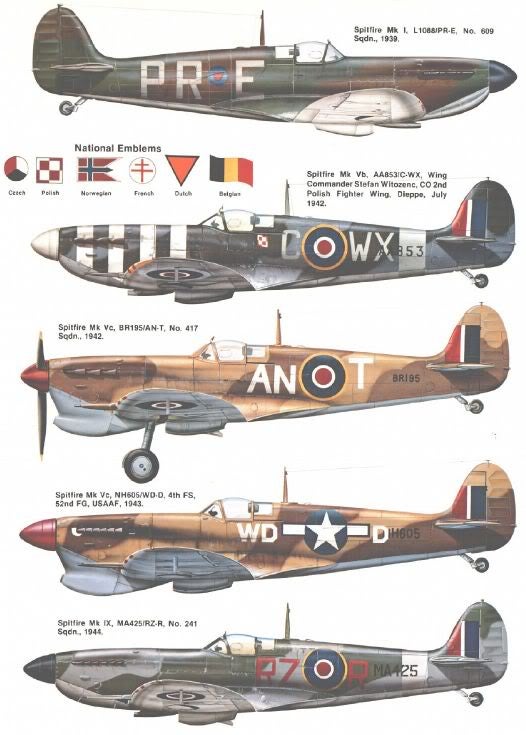
Although the Mark1 was what started it all, I really like the sleeker looks of the later versions
 pip bip - choose Corrour
> ttyymmnn
pip bip - choose Corrour
> ttyymmnn
03/07/2018 at 05:28 |
|
bugger, i missed out on flying Hooters.
 pip bip - choose Corrour
> ttyymmnn
pip bip - choose Corrour
> ttyymmnn
03/07/2018 at 07:38 |
|
don’t forget Thursday (8/3/14) MH370 disappeared, still searching.
 ttyymmnn
> pip bip - choose Corrour
ttyymmnn
> pip bip - choose Corrour
03/07/2018 at 08:17 |
|
Yup. I forgot it last year, but wrote a long article for it this year. I actually put it on my calendar so I wouldn’t forget. Thanks.
 gmporschenut also a fan of hondas
> Smallbear wants a modern Syclone, local Maple Leafs spammer
gmporschenut also a fan of hondas
> Smallbear wants a modern Syclone, local Maple Leafs spammer
03/07/2018 at 20:39 |
|
MY friend had a russian professor that used to work for the soviet space program. after the soviet union broke up the company that made the was in ukraine and refused to sell the laser range finders/guidence system that they used to dock the capsules to MIR. As the sensor were outside they capsule they woud get trashed in reentry. the solution was to fit a telescope with lines and a stopwatch to estimate approach speed..